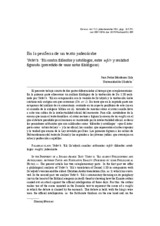Mostrar el registro sencillo del ítem
En la periferia de un texto judeoárabe: Yefet b. þEli contra filósofos y astrólogos, entre tafsīr y realidad figurada (precedido de unas notas filológicas)
| dc.contributor.author | Monferrer-Sala, J. P. | |
| dc.date.accessioned | 2012-08-31T11:33:29Z | |
| dc.date.available | 2012-08-31T11:33:29Z | |
| dc.date.issued | 2011 | |
| dc.identifier.uri | http://hdl.handle.net/10396/7786 | |
| dc.description.abstract | El presente trabajo consta de dos partes diferenciadas al tiempo que complementarias. En la primera parte ofrecemos un análisis filológico de la traducción de Da 1:20 realizada por Yefet b. þEli en comparación con la versión de Saþadyah y la traducción árabe cristiana más antigua con que contamos (Sin. ar. 1). En tanto que en la segunda parte nos ocupamos del análisis de su comentario, centrado en un aspecto periférico de este (no en el corazón de la exégesis bíblica en sí), tratando de mostrar cómo el autor caraíta lleva a cabo una crítica de la intelectualidad oficial del momento. Para ello, sirviéndose de la escena que narra el texto daniélico, el autor recurre a figurar la escena de un malis en el que el debate presidido por el monarca es mantenido por la intelectualidad oficial, es decir los pensadores rabbanitas que son calificados como ‘filósofos y astrólogos’ –que él interpreta como ‘sabios del rey’–, y la no oficial, los caraítas, que representan el saber superior y la verdad que emana de la Ley revelada por Dios. Los primeros figuran a los sabios de Nabucodonosor del texto de Daniel y los segundos a los jóvenes judíos, que aventajan en saber y perfección a aquéllos. | es_ES |
| dc.description.abstract | In the Periphery of a Judaeo-Arabic Text: Yefet b. þEli against Philosophers and Astrologers, between Tafsīr and figurative reality (preceded by some Philological Notes).— The present article has two complementary parts. In the first part we offer a philological analysis of Yefet b. þEli’s translation of Daniel 1:20 in comparison with Saþadyah’s version and the oldest Christian Arabic translation (Sin. ar. 1) which has survived. In the second part, we analyse Yefet b. þEli’s commentary focusing on its periphery (not in the heart of the Biblical exegesis in itself) thereby showing how the Karaite author carried out an attack against the official intelligentsia of those days. For this, the author makes use of the scene narrated in the Danielic text to represent the scene of a malis in which the debate is chaired by the monarch. This debate is held, with the king’s wise men, the official intelligentsia, i.e. the Rabbanite thinkers, on the one hand and, on the other hand, the non-offical thinkers, the Karaites, who represent the superior knowledge and the truth which emanates from the Law revealed by God. The Rabbanites represent Nebuchadnezzar’s wise men of Daniel’s text, and the Karaites are Daniel and the young Jews, who are superior to them in science and perfection. | es_ES |
| dc.format.mimetype | application/pdf | es_ES |
| dc.language.iso | spa | es_ES |
| dc.publisher | Consejo Superior de Investigaciones Científicas (CSIC) | es_ES |
| dc.rights | https://creativecommons.org/licenses/by-nc-nd/4.0/ | es_ES |
| dc.source | Sefarad 71 (2), 265-291 (2011) | es_ES |
| dc.subject | Yefet b. þEli | es_ES |
| dc.subject | Saþadyah | es_ES |
| dc.subject | tafsīr | es_ES |
| dc.subject | malis | es_ES |
| dc.subject | Caraitas | es_ES |
| dc.subject | Rabbanitas | es_ES |
| dc.subject | Filósofos | es_ES |
| dc.subject | Astrólogos | es_ES |
| dc.subject | Judeo-Arabic | es_ES |
| dc.title | En la periferia de un texto judeoárabe: Yefet b. þEli contra filósofos y astrólogos, entre tafsīr y realidad figurada (precedido de unas notas filológicas) | es_ES |
| dc.type | info:eu-repo/semantics/article | es_ES |
| dc.rights.accessRights | info:eu-repo/semantics/openAccess | es_ES |

